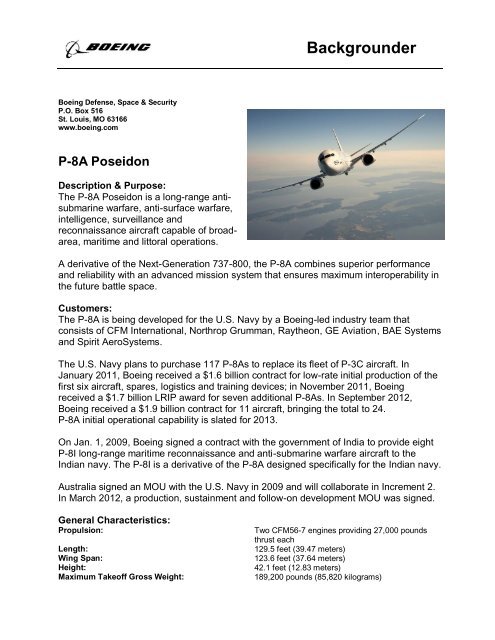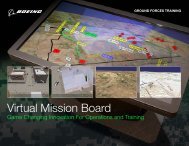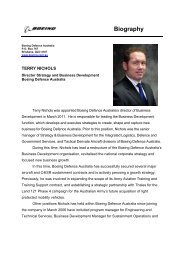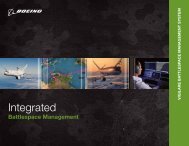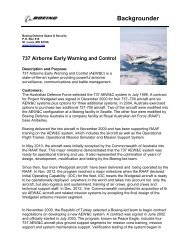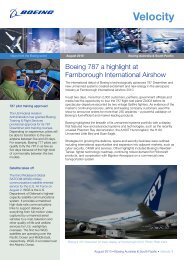P-8A - Boeing Australia
P-8A - Boeing Australia
P-8A - Boeing Australia
You also want an ePaper? Increase the reach of your titles
YUMPU automatically turns print PDFs into web optimized ePapers that Google loves.
Backgrounder<strong>Boeing</strong> Defense, Space & SecurityP.O. Box 516St. Louis, MO 63166www.boeing.comP-<strong>8A</strong> PoseidonDescription & Purpose:The P-<strong>8A</strong> Poseidon is a long-range antisubmarinewarfare, anti-surface warfare,intelligence, surveillance andreconnaissance aircraft capable of broadarea,maritime and littoral operations.A derivative of the Next-Generation 737-800, the P-<strong>8A</strong> combines superior performanceand reliability with an advanced mission system that ensures maximum interoperability inthe future battle space.Customers:The P-<strong>8A</strong> is being developed for the U.S. Navy by a <strong>Boeing</strong>-led industry team thatconsists of CFM International, Northrop Grumman, Raytheon, GE Aviation, BAE Systemsand Spirit AeroSystems.The U.S. Navy plans to purchase 117 P-<strong>8A</strong>s to replace its fleet of P-3C aircraft. InJanuary 2011, <strong>Boeing</strong> received a $1.6 billion contract for low-rate initial production of thefirst six aircraft, spares, logistics and training devices; in November 2011, <strong>Boeing</strong>received a $1.7 billion LRIP award for seven additional P-<strong>8A</strong>s. In September 2012,<strong>Boeing</strong> received a $1.9 billion contract for 11 aircraft, bringing the total to 24.P-<strong>8A</strong> initial operational capability is slated for 2013.On Jan. 1, 2009, <strong>Boeing</strong> signed a contract with the government of India to provide eightP-8I long-range maritime reconnaissance and anti-submarine warfare aircraft to theIndian navy. The P-8I is a derivative of the P-<strong>8A</strong> designed specifically for the Indian navy.<strong>Australia</strong> signed an MOU with the U.S. Navy in 2009 and will collaborate in Increment 2.In March 2012, a production, sustainment and follow-on development MOU was signed.General Characteristics:Propulsion:Length:Wing Span:Height:Maximum Takeoff Gross Weight:Two CFM56-7 engines providing 27,000 poundsthrust each129.5 feet (39.47 meters)123.6 feet (37.64 meters)42.1 feet (12.83 meters)189,200 pounds (85,820 kilograms)
Speed:490 knots (564 mi/h, 789 km/h)Range: 1,200+ nautical miles, with 4 hours on station (1,381miles, 2,222 kilometers)Ceiling:41,000 feet (12,496 meters)Crew: 9<strong>Boeing</strong> is using a first-in-industry production process and its existing Next-Generation737 production system to efficiently design and build P-8 aircraft. The P-8’s 737-800fuselage is built in Wichita, Kan., and then sent to <strong>Boeing</strong>’s final assembly facility inRenton, Wash., where all aircraft structural features unique to the P-<strong>8A</strong> are incorporatedin sequence during fabrication and assembly. Aircraft quality and performanceacceptance flight testing takes place at Renton Field and final installation and checkoutof the mission system and special flight test instrumentation is conducted at <strong>Boeing</strong> Field.The first test aircraft began U.S. Navy formal flight testing at <strong>Boeing</strong> Field in late 2009and ferried to Naval Air Station Patuxent River, Md., on April 10, 2010, for completion offlight test. Six P-<strong>8A</strong> test aircraft currently are in flight test. <strong>Boeing</strong>’s first production P-<strong>8A</strong>made its initial flight July 7, 2011 and was officially delivered to the Navy March 4, 2012.The second production plane was delivered July 17, 2012; the third aircraft deliveredSeptember 6, 2012; the fourth delivered October 8, 2012 and the fifth November 2, 2012.Background:<strong>Boeing</strong> was awarded a $3.89 billion contract for the system development anddemonstration (SDD) phase of the program on June 14, 2004. SDD activities includedeveloping and integrating all the necessary software and onboard mission systems anddeveloping training systems. The P-<strong>8A</strong> is expected to significantly transform how theNavy’s maritime patrol and reconnaissance force will train, operate and deploy.The initial SDD contract included building five test vehicles: three flight test aircraft (T1,T2 and T3), one full-scale static test airframe and one full-scale fatigue test airframe (S1and S2). The contract included an option for two additional test vehicles (T4 and T5),which has since been exercised. One additional flight test aircraft (T6) also was added tothe contract.In November 2005 the Navy announced that the P-<strong>8A</strong> preliminary design review (PDR)was the best major weapons system PDR it had ever reviewed. A successful criticaldesign review was completed in July 2007.The team started production on the first test aircraft on Dec. 11, 2007, at Spirit’s facility.Fuselage assemblies come together on Spirit’s existing Next-Generation 737 productionline. Spirit delivered the first fuselage to <strong>Boeing</strong> in late March 2008 and final assembly ofthe aircraft began the same day in Renton, Wash. The P-<strong>8A</strong> made its first flight on April25, 2009. Full-scale static testing of the P-<strong>8A</strong>’s airframe was completed in January 2011.The Navy has surpassed 2,800 flight-test hours in the P-<strong>8A</strong> test aircraft.
Industry Partners:<strong>Boeing</strong> and its industry partners provide unrivaled expertise in both large-scale systemsintegration and network centric operations, plus unquestioned leadership in developingand customizing military and commercial products for maritime forces.CFM International, a 50/50 joint company of Snecma Moteurs and General ElectricCompany, provides the CFM56-7 engines that power the P-<strong>8A</strong>. The two engines eachprovide 27,300 pounds of takeoff thrust. The CFM56-7 is one of the world’s most reliableengines. This fleet of engines has logged more than 30 million flight hours whilemaintaining an industry-leading .002 percent in-flight shut down rate per 1,000 hours offlight.Northrop Grumman’s Electronic Systems sector provides the directional infraredcountermeasures system, and the electronic support measures system. NorthropGrumman’s Aerospace Systems sector develops data links for P-<strong>8A</strong>; the company’sIntegrated Systems sector supports the mission planning effort.Raytheon provides the AN/APY-10 radar which delivers all weather, day/night multimissionmaritime, littoral and overland surveillance capabilities. Raytheon also providesthe MK 54 lightweight torpedo.GE Aviation supplies both the Flight Management and Stores Management systems onthe P-<strong>8A</strong>. The Flight Management System provides an integrated open architecture thatis CNS/ATM compatible along with an inherent growth path for upgrades. The StoresManagement System provides a comprehensive system for the electronic control ofintegrated weapons management.Spirit AeroSystems builds the 737 aircraft’s fuselage and airframe tail sections andstruts in Wichita, Kan. Spirit supplies large component parts and assemblies for anumber of <strong>Boeing</strong> commercial aircraft.BAE Systems provides the mission computing and display system (MCDS), flight deckpanels and data diode.###Contact:Chick Ramey<strong>Boeing</strong> Surveillance and Engagement+1 253-657-5636charles.b.ramey@boeing.comNovember 2012


